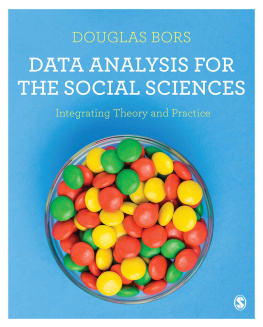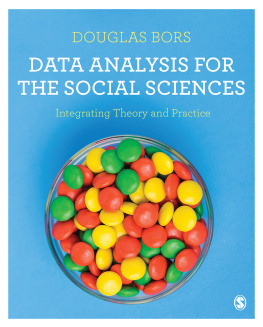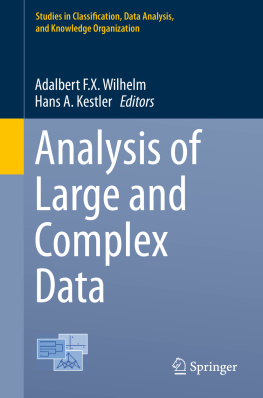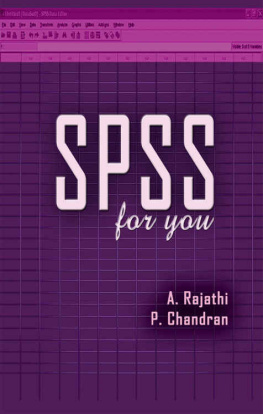Douglas Bors - Data Analysis for the Social Sciences
Here you can read online Douglas Bors - Data Analysis for the Social Sciences full text of the book (entire story) in english for free. Download pdf and epub, get meaning, cover and reviews about this ebook. year: 2018, publisher: SAGE Publications, genre: Children. Description of the work, (preface) as well as reviews are available. Best literature library LitArk.com created for fans of good reading and offers a wide selection of genres:
Romance novel
Science fiction
Adventure
Detective
Science
History
Home and family
Prose
Art
Politics
Computer
Non-fiction
Religion
Business
Children
Humor
Choose a favorite category and find really read worthwhile books. Enjoy immersion in the world of imagination, feel the emotions of the characters or learn something new for yourself, make an fascinating discovery.
- Book:Data Analysis for the Social Sciences
- Author:
- Publisher:SAGE Publications
- Genre:
- Year:2018
- Rating:3 / 5
- Favourites:Add to favourites
- Your mark:
- 60
- 1
- 2
- 3
- 4
- 5
Data Analysis for the Social Sciences: summary, description and annotation
We offer to read an annotation, description, summary or preface (depends on what the author of the book "Data Analysis for the Social Sciences" wrote himself). If you haven't found the necessary information about the book — write in the comments, we will try to find it.
Data Analysis for the Social Sciences — read online for free the complete book (whole text) full work
Below is the text of the book, divided by pages. System saving the place of the last page read, allows you to conveniently read the book "Data Analysis for the Social Sciences" online for free, without having to search again every time where you left off. Put a bookmark, and you can go to the page where you finished reading at any time.
Font size:
Interval:
Bookmark:

Integrating Theory and Practice
Second Edition
- Douglas Bors


SAGE Publications Ltd
1 Olivers Yard
55 City Road
London EC1Y 1SP
SAGE Publications Inc.
2455 Teller Road
Thousand Oaks, California 91320
SAGE Publications India Pvt Ltd
B 1/I 1 Mohan Cooperative Industrial Area
Mathura Road
New Delhi 110 044
SAGE Publications Asia-Pacific Pte Ltd
3 Church Street
#10-04 Samsung Hub
Singapore 049483
Douglas Bors 2018
First published 2018
Apart from any fair dealing for the purposes of research or private study, or criticism or review, as permitted under the Copyright, Designs and Patents Act, 1988, this publication may be reproduced, stored or transmitted in any form, or by any means, only with the prior permission in writing of the publishers, or in the case of reprographic reproduction, in accordance with the terms of licences issued by the Copyright Licensing Agency. Enquiries concerning reproduction outside those terms should be sent to the publishers.
IBM SPSS screen shot reprints courtesy of International Business Machines Corporation, International Business Machines Corporation Foundation
Library of Congress Control Number: 2017939133
British Library Cataloguing in Publication data
A catalogue record for this book is available from the British Library
ISBN 978-1-4462-9847-3
ISBN 978-1-4462-9848-0 (pbk)
Editor: Jai Seaman
Assistant editor: Alysha Owen
Production editor: Ian Antcliff
Copyeditor: Richard Leigh
Proofreader: Neville Hankins
Indexer: Silvia Benvenuto
Marketing manager: Susheel Gokarakonda
Cover design: Shaun Mercier
Typeset by: C&M Digitals (P) Ltd, Chennai, India
Printed in the UK


Data Analysis for the Social Sciences: Integrating Theory and Practice is supported by a wealth of online resources for both students and lecturers to aid study and support teaching, which are available at https://study.sagepub.com/bors.
An introduction video from author Doug Bors gives you the chance to get to know your supporting statistics tutor and understand the fundamental principles of statistics.
A maths diagnostic pre-test helps you test or review your mathematical skills.
Interactive demonstrations and simulations offer hands-on experience in working with data and critical insight into evaluating numerical information.
SPSS datasets allow you to get to grips with the ins and outs of IBM SPSS software and practice the techniques you learn with real data.
Answers to the in-text review, challenge, and end of chapter questions give you the opportunity to check your work and identify areas in which you may need additional support.
PowerPoint slides featuring figures, tables, and key topics from the book can be downloaded and customized for use in your own presentations.

Acknowledgements are always difficult. There is never sufficient room to mention everyone who played a role in the development of your thoughts and in the production of a book. Should anyone feel overlooked, I apologize. I have been blessed with dedicated and thoughtful teaching assistants and graduate students. Many of their thoughts and comments about teaching and learning statistics have found their way into this book. There are far too many to name them all. A few deserve special mention, however. Dr. Blair Armstrong (now a professor and a valued colleague), Dr. Tim Cheng, Ron Chu, and Dwayne Pare have contributed in many ways. Ron Chu also programmed the interactive demonstrations found on the books online resources page, at https://study.sagepub.com/bors. This book would have been further delayed if not for the insight and the eleventh-hour magical technical help of Adon Irani. He also produced and directed the books introductory video. Adons remarkable efforts were more than that of a colleague and friend; they reflect his truly kind-hearted nature. The support of the Department of Psychology at the University of Toronto at Scarborough and its Chair, Professor George Cree, must be recognized. Professor Gerald Cupchik deserves special mention for his constant encouragement which began long before Sage approached me. The Department provided monetary and personnel support at crucial times during the preparation of the manuscript. My friend and colleague Professor Gerald Cupchik deserves special mention for his encouragement, which began long before SAGE approached me. My wife va Szkely must be acknowledged for her infinite patience and support throughout the long process, for her careful readings of the manuscript, and for helpful comments. va also kept our ship afloat during my mental secondment. My mother-in-law, Magda, must be thanked for brewing me several espressos every day. She seemed to sense when I was in need. I would be remiss if I did not acknowledge our beloved calico cat, Minou, for sitting on my desk day in and day out, keeping my blood pressure down. I need to thank Michael Carmichael at Sage for inviting me to write this book. Finally, I am grateful to Jai Seaman and Alysha Owen at Sage for their support and help in the process. Mr. Richard Leigh, must be thanked for his meticulous reading and editing of the text. Although those mentioned above were of immense help, any errors found in this book are the sole responsibility of the author.
This book is intended to provide students in the behavioural and social sciences with a comprehensive conceptual introduction to a full range of statistical techniques used to describe and analyse data generated by both experimental and observational research designs. By conceptual I mean a way of understanding the logic and basic principles that generate statistical procedures and tests. Although the primary goal of the book is to give you a conceptual appreciation of statistics, this book does not avoid formulae and computations. The detailed presentation of formulae and the working through of computational examples, however, are always aimed at fostering your conceptual understanding of the material. To this end, computational examples are kept simple so that you can follow along. After these simple hand calculations, when larger data sets are analysed, SPSS (a statistical software package) will do the number crunching for you. Should you wish to test or review your mathematical skills, you can find a brief quiz on the textbooks web page; a link for it is at the end of this preface. The quiz is focused on those skills necessary for understanding the formulae and following the hand calculations.
Font size:
Interval:
Bookmark:
Similar books «Data Analysis for the Social Sciences»
Look at similar books to Data Analysis for the Social Sciences. We have selected literature similar in name and meaning in the hope of providing readers with more options to find new, interesting, not yet read works.
Discussion, reviews of the book Data Analysis for the Social Sciences and just readers' own opinions. Leave your comments, write what you think about the work, its meaning or the main characters. Specify what exactly you liked and what you didn't like, and why you think so.





